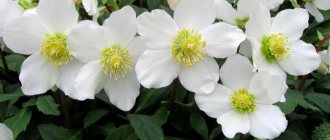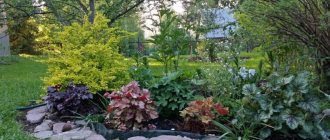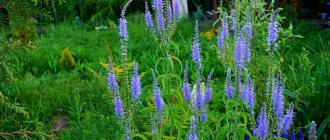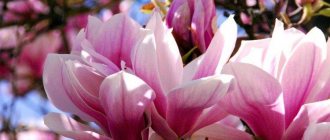Boxwood is the oldest ornamental shrub, widely used in landscape designs. With its help, beautiful hedges and flower arrangements are created, landscaping is carried out, original borders and frames for lawns are created. Since boxwood is an evergreen plant, it looks attractive on the site even in winter.
In this article we will look at what boxwood is, what common types and varieties are suitable for landscape designs, what planting rules should be followed, what kind of soil boxwood likes, how to care for shrubs and much other useful information.
Features of growing boxwood
The use of ornamental plants allows you to turn any garden into a real work of art. Boxwood is an evergreen shrub widely used in landscape design. It originally grew in warm climates, but over time it was domesticated and began to be grown almost all over the world.
Boxwood is easy to care for, but needs protection from direct sunlight
A feature of the shrub is its heat-loving nature. It is very important to pay attention to this point when planting and caring for evergreen boxwood. Despite the fact that the shrub is most widespread in Russia in the southern regions, it is actively grown from the Urals to the Moscow region. There are 2 main points that must be observed when growing:
- Boxwood does not tolerate direct sunlight. Planting is done in shaded areas of the garden.
- The shrub is picky about soil. Plant development on poor soils slows down significantly. Land with a high percentage of lime content is best suited.
If desired, boxwood can be planted in almost any region of Russia. If it is grown in an unfavorable climate, in order to obtain maximum decorative value, it is necessary to strictly follow all the rules for caring for it.
Botanical description, species
Boxwood, planting and caring for it in open ground is common among gardeners in different parts of the world, has spread throughout the world from the forests of the Mediterranean and East Asia. The Latin name of the plant is “Búxus”, in Russian the names “gevan”, “bukshpan” and “buks” are found.
In botanical taxonomy, boxwood is part of the boxwood family of the same name, which in natural conditions includes about 100 species. In gardening, single species are used, on the basis of which new breeding varieties are developed. Depending on the species, boxwood is a shrub or a highly branched tree.
Without pruning, wild varieties can reach 12 m in height, but crown growth is slow - only 5-6 cm per year.
Mature branches of boxwood are hard and brown in color. Young shoots are soft, light green in color, darken and harden over time. Buxus wood is superior in strength and hardness to all species known in Europe. In areas where there are thickets of boxwood in nature, the wood is used to make small wooden products.
The crown of the boxus is very dense, consisting of many small branches. The leaves are short-petioled, oval-shaped, arranged oppositely. The foliage color is uniform, dark green.
Flowering boxwood can only be observed in the southern regions. In mid-latitude conditions, such an event occurs extremely rarely. Small white flowers collected in paniculate inflorescences appear in early spring. They are not particularly beautiful, but they exude a pleasant sweet smell. After flowering, capsule fruits with black oblong seeds are formed.
Types and varieties that are most common in gardening:
| View | Description | Popular varieties |
| Evergreen | A tall growing tree with a dense crown and small glossy leaves. The species is very thermophilic and does not tolerate frost. |
|
| Colchis | The relict species is a long-liver, individual specimens of which live for about 600 years. The leaves are very small. Tolerates cold well. | It is rarely used in garden design. |
| small-leaved | Cold-resistant, compact species native to China and Japan. The leaves are small, almost round in shape. |
|
When can you plant boxwood in open ground?
Despite the fact that the best time for planting most plants is early spring, the most favorable period for rooting boxwood shrubs is autumn. The main reason for not planting in spring is the rather early swelling of the buds - in boxwood it occurs at the very beginning of March.
Important! Rooting of seedlings in early spring is possible only in the event of a sharp cold snap in September.
In order for the root system to completely take root in a new location, it takes 3 to 4 weeks. It is important that the temperature during this period does not fall below 0 degrees. After complete rooting, boxwood easily endures the winter period.
Fertilizer and feeding
After planting, boxwood can be fed with mineral fertilizers no earlier than a month later. Further feeding is carried out in spring and autumn, as well as after each pruning of the bush.
Mineral fertilizer for boxwood should contain phosphorus, nitrogen and potassium. These are necessary components that ensure normal growth and branching of the shrub. In the autumn, fertilizers containing potassium salt and nitrogen are used for feeding.
A mullein solution diluted with water in a ratio of 1:10, respectively, or chicken manure in a ratio of 1:20 is ideal as an organic fertilizer for buxus.
Flower shops offer a wide range of preparations for feeding boxwood. Complex fertilizers fully satisfy the nutritional needs of shrubs, increase immunity and promote the rapid growth of green mass.
How to plant boxwood on a plot
In order for the plant to achieve its decorative appearance as quickly as possible, it is necessary to approach the issue of planting responsibly. Proper selection of location and soil preparation is the key to rapid growth of boxwood.
When planting, it is very important to consider some features:
- place on the site;
- soil type;
- distance between bushes;
- plants whose proximity will improve the growth of boxwood.
Before planting a shrub, it is necessary to carefully study all external factors.
Only if you observe all the subtleties that must be taken into account when planting an evergreen shrub, you can get a healthy ornamental plant. Properly followed agricultural techniques will avoid further problems with care or replanting.
Where to plant boxwood
When choosing a location for a shrub, there are several important details to consider. The first step is to ensure that future plantings are protected from excessive sunlight. It is best to choose a shaded area so that the sun does not harm the plant.
Boxwood is planted next to high fences or in the area adjacent to the house. An excellent place for a bush is the space between large trees that will shade it. The most destructive thing for boxwood branches is the winter sun. During the cold period, it must be covered with a cloth to avoid the shoots dying off.
What kind of soil does boxwood like?
Since the plant is a perennial, it is very important to properly prepare the soil for planting it. This will make caring for the boxwood easier in the future. In addition, a healthy plant planted in favorable soil will not require replanting.
A distinctive feature of boxwood is its unpretentiousness to the type of soil on which it grows. However, there are several soil requirements. Loamy and sandy loam soils are best suited for boxwood. The humidity level should be moderate - stagnation of moisture has a detrimental effect on the root system of the plant.
Important! Experts do not advise planting boxwood in areas with high groundwater levels.
For best growth of shrubs, neutral or slightly acidic soil is most suitable. You can improve the balance of the soil by adding compost or slaked lime. It is important that the planting site has good drainage to remove water. To improve soil aeration, tree trunk circles are periodically dug up.
At what distance to plant boxwood?
Modern landscape designers actively use shrubs to improve areas. It is planted both as free-standing plants and as a hedge. In the first case, boxwoods are planted singly or at a distance of 1.5-2 m from each other.
When creating a hedge, the minimum distance between bushes is 30 cm
If a gardener grows shrubs as a natural hedge, they are planted much closer to each other. To do this, dig a long trench. Seedlings are placed in it at a distance of at least 30 cm from each other. With denser planting, the root systems become intertwined, complicating the active growth of the plant.
What can be planted next to boxwood?
The shrub achieves its most harmonious appearance when combined with other ornamental plants. Boxwood fits best in tall flower beds.
Good neighbors for him are:
- rose bushes;
- jasmine;
- lilac;
- cistus;
- barberry.
Landscape designers recommend combining the deep green color of boxwood with brighter plants. Blue, pink and white flowers will create a unique contrast. In addition, a lush boxwood bush can provide a natural wind and sun protection for shorter plants and flowers.
A separate way to create a composition from boxwood bushes is to decorate artificial ponds on your personal plot. In this case, they go well with daylily, calamus and marigold. In the autumn, after the leaves have fallen, the evergreen bush will retain the attractiveness of the pond.
How to plant boxwood correctly
Planting a shrub is a fairly simple procedure, but it requires compliance with some subtleties necessary for its further development. The first step is to prepare the planting holes. Their size should be 2-3 times the volume of the root system of the seedling.
Important! Planting holes are dug in advance - 2-3 months before planting.
Perlite is used as drainage. It is poured onto the bottom of the hole in a layer of 5-10 cm. Perlite is also mixed with leaf soil, which will later be sprinkled on the seedling. After this, the boxwood is placed in the recess so that the root collar is flush with the ground. The soil is lightly trampled, then watered abundantly.
Some time after planting, the soil around the seedling will fall slightly. The resulting hole is sprinkled with perlite - this will retain more moisture. Perlite also ensures limited evaporation of water from tree trunks.
Common types and varieties of boxwood
Evergreen boxwood
In total, there are more than 30 species of this crop, which have unique features. They all differ in: growth, requirements for care, decorativeness, bark color, shape and color of leaves, and so on. In gardening, only the following plant varieties are found predominantly:
- Colchian _ The variety is listed in the Red Book. Its homeland is the Caucasus. The plant grows at a very slow pace. It is distinguished by small and fleshy leaves and high resistance to frost;
- evergreen (Caucasian palm) . It grows in the wild in the Caucasus and Mediterranean countries. It can be planted both in sunny meadows and in the shade. If the bushes are not trimmed, their height can reach 3 m;
- Balearic _ It is considered the largest representative of its genus. Its leaves can reach a length of 5 m. It grows in nature on the Crimean coast, southern Spain, and Portugal. Homeland: Balearic Spanish Islands;
- small-leaved . It is a dwarf variety that copes well with severe frosts. This variety is valued by gardeners for its high decorative qualities and comfortable size.
How to care for boxwood
After planting the seedlings in open ground, the active growing season begins. The shrub grows green mass. It is in the first few years that it needs maximum attention and care, otherwise it will begin to turn yellow and gradually dry out.
High-quality shrub care is the key to a bright green crown
Despite the fact that boxwood is quite easy to care for, regular care will help maintain the health of the plant. Periodic watering, fertilizing, loosening the tree trunks and pruning bushes are the key to the longevity of the bush.
How often to water boxwood
Like any other plant, ornamental shrubs need additional irrigation. Boxwood is quite sensitive to excess moisture. With an abundance of water, the boxwood root system begins to rot and die. For normal life, it is enough to water the bush once a week.
Important! During rainy periods it is necessary to refrain from watering. There will be enough natural precipitation.
You should not moisten the entire trunk circle - the moisture should flow directly under the root. Over-watering leaves on sunny days can cause damage and wilting. To wash off dust and dirt from the leaves, they are treated in the evening.
Feeding schedule
Regular care and application of complex fertilizers is the key to a healthy plant. The very first fertilizing is done a month after planting. The soil of the planting pits is fertilized with wood ash and compost. The introduction of complex chemical additives in the first months after rooting of a seedling is not recommended.
An adult plant requires more careful adherence to the feeding schedule. In early spring, fertilizers containing nitrogen are applied - this improves the growing season and promotes the active growth of green mass. In the autumn, boxwood is fed with phosphorus and potassium complexes.
Loosening and mulching
Since boxwood has a negative attitude towards waterlogging of the soil, it is necessary to periodically treat the tree trunk circles. They are dug or loosened with a hoe. This provides improved aeration and oxygen flow to the root system. Loosening is carried out 2 times a year - after the snow melts and at the beginning of autumn.
Loosening is a very important component of boxwood care
In addition to treating the tree trunks, shrubs must be mulched. As soon as the soil has completely warmed up after the winter period, it is sprinkled with peat. The mulch layer should be 5-7 cm. In this case, the peat should not touch the young shoots and the trunk of the plant.
Pruning rules
For high-quality growing season, any ornamental plant needs timely pruning. Two types of such procedures are applied to boxwood - decorative and sanitary. The first is necessary to create a beautiful crown. Depending on the desired shape of the future shrub, either a ball or a hedge is formed.
Important! After each decorative pruning it is necessary to apply complex fertilizers.
Sanitary pruning is a procedure performed in early spring. Its main purpose is to remove dead shoots. Using pruners, remove damaged branches down to healthy areas. After pruning, the shoots are treated with garden varnish.
Preparing for winter
The cold period is the most dangerous for all plants. Proper preparation of boxwood for winter is the key to preserving its ability to further grow. Before the onset of the first frost, the tree trunk circles are additionally covered with a layer of sawdust mulch.
Important! To prevent heavy snowfalls from breaking off the branches, they are tied to the trunk with twine or a clothesline.
As soon as the ambient temperature drops below -10 degrees, the boxwood must be covered with cloth or roofing felt. You can also use spruce branches or branches of other plants as insulation.
Planting a plant
The stone tree can also grow on depleted lands, then the crown will grow even more slowly.
Place and soil
Boxwood loves partial shade. Loams with neutral acidity are suitable for planting boxwood The soil should be loose, fertile, breathable, and have drainage. On this land a bush grows with dense foliage, powerful, with shiny leaves.
Landing Features
Boxwood is planted on the site in the spring , when warm days arrive. The roots take root in a month, so in the fall you need to count the time until the cold weather, that is, to sub-zero temperatures, so that the heat-loving crop does not die. The day before transplanting, water the crop thoroughly to make it easy to remove the boxwood from the pot.
- Dig the planting hole so that it is 3-3.5 times wider and deeper than the roots with the earthen lump of the crop;
- Place a 2-3 cm layer of perlite on the bottom, it will serve as drainage;
- Mix part of the soil dug from the hole with the same amount of perlite, i.e. 1:1;
- Pour soil into the hole, make a cone out of it, place a bush on it, straighten the rhizome well so that it lies straight;
- Cover the seedling with soil. Compact the soil with your hands so that there are no voids near the roots;
- Pour in settled water. For a seedling 15-20 cm high, 3 liters of water are required;
- When the soil settles, add more soil with perlite, but you don’t have to compact it anymore;
- Close to the boxwood in a circle, make a roller of soil 20-30 cm high so that when watering the water does not go beyond this circle.
Advice! If you want to make a hedge, then plant the buscus at a distance of 25 cm. If you are planting the frame of a flower bed, then the boxwood should be 10-15 cm high, and the space between the plants should be 10 cm. Then after planting, the bushes should be cut by 1/3. But between tall boxwood trees, keep a distance of 3-4 m.
Features of growing and caring for boxwood in the regions
Landscape designers grow shrubs not only in the warm regions of Russia. Modern methods of agricultural technology make it possible to maintain boxwood in household plots throughout the country from Leningrad to eastern Siberia.
To get a healthy plant, when caring for it, it is important to take into account the specifics of your region:
- in the northern regions of the European part of the country, waterlogging of the soil should be actively monitored, limiting watering as much as possible;
- even in central Russia it is necessary to remember about rare but severe frosts - several times a year the temperature can drop to -25 degrees;
- in the Urals and Siberia, the most important part of caring for boxwood is preparing for winter.
For each region, the rules for caring for the plant can vary significantly.
In addition to the severe cold of the Ural region, local gardeners have to take into account fairly early frosts. This means the practical impossibility of rooting the shrub in the autumn. Gardeners are forced to plant boxwood in the spring, sacrificing the active growing season of the first year of life.
Trimming
Pruning of bushes is carried out in order to give them various geometric shapes. The procedure must be carried out with a special tool for pruning shrubs. Garden shears must be sharp so as not to damage the shoots.
It is not recommended to prune the bush in the first year after planting. Next year, you can trim the buxus at the end of April - beginning of May.
Having once formed the shape of a bush, subsequently it will only need to be maintained, since boxwood grows slowly. Only growing young shoots need to be removed. Correction of old shoots may be necessary when the shape of the bush is completely lost.
After each pruning, the plant needs fertilizing with mineral fertilizers to replenish the lost composition of nutrients and accelerate growth. Boxwood needs to be trimmed regularly, about once a month.
Caring for boxwood at home
Ornamental shrubs can be grown not only in open ground. Housewives often cultivate boxwood at home. It is planted in special tubs and decorated with living quarters.
In the case of such cultivation, there are several tips for caring for boxwood:
- in winter, it is placed in a cool room with a temperature of about 15-16 degrees;
- it is necessary to ensure sufficient soil moisture, avoiding excessive watering;
- as with a garden plant, periodic fertilizing is important.
The most important advantage of growing boxwood at home is that there is no need to prepare for wintering. Since the room is constantly maintained at a positive temperature, there is no need for a set of measures to insulate the plant.
Use in landscape design
Boxwood or buxus is undoubtedly the most favorite plant of garden designers. A simple plant at first glance allows you to create incredibly beautiful forms. Since ancient times, sculptural and carpet compositions made of boxwood have decorated the gardens of royal palaces and temple complexes. There are many options for compositions; boxwood is ready to fulfill any designer’s fantasy.
- The ability to grow safely close together has made boxwood an ideal plant for a dense hedge.
- Compact miniature varieties are used to decorate borders and alpine slides.
- In large open spaces, boxwood is used for wide-area geometric flower beds. It goes well with flower arrangements and other types of ornamental shrubs.
- Boxwood plantings are appropriate in the design of both personal plots and courtyards of official buildings.
- Boxwood develops equally well in single, group plantings and in separate containers.
Diseases and pests
It happens that despite strictly following the rules for caring for boxwood, the shrub begins to wither and wither. Most often, the cause of this is various diseases.
Boxwood ailments include:
- necrosis;
- cancer;
- rust.
Most often, problems are caused by the development of fungal diseases. When the first signs of damage to leaves or branches appear, the entire bush must be treated with a fungicide. After this, the dead shoots are removed, and the boxwood is additionally treated with a solution of copper sulfate.
In addition to diseases, shrubs can be damaged by pests. The most dangerous for plantings are boxwood moth, flea, felt and spider mites. Infected bushes require timely care - treatment with karbofos or Tagore.
Reproduction of indoor boxwoods
Boxwoods are propagated by cuttings. For indoor shrubs, you can use spring and summer cuttings, but not completely lignified shoots: you can cut the branches at the stage when only the base has become lignified. The last cuttings of indoor boxwoods are taken in early July.
Standard cuttings of this shrub are up to 7 cm long (with at least two internodes). The lower leaves can be removed, leaving only the upper pair. Oblique cuts below the knot are a classic option. Cuttings also take root in ordinary water, but most often they prefer a more reliable method: they are buried at an angle in a sandy soil mixture or ordinary substrate, and kept under a hood. Provided stable humidity and frequent ventilation are created, cuttings can take root within a month after planting. They are grown in larger containers. Bottom heating and treatment with growth stimulants increases the speed and improves the quality of rooting.
The seed method for indoor boxwoods can be used, but it is used extremely rarely due to the duration of subsequent growing of plants until they achieve maximum decorativeness.
Maybe some of the Botanichka readers are already growing boxwood indoors. We will be grateful if you share your experience in the comments to this article or on our Forum.











